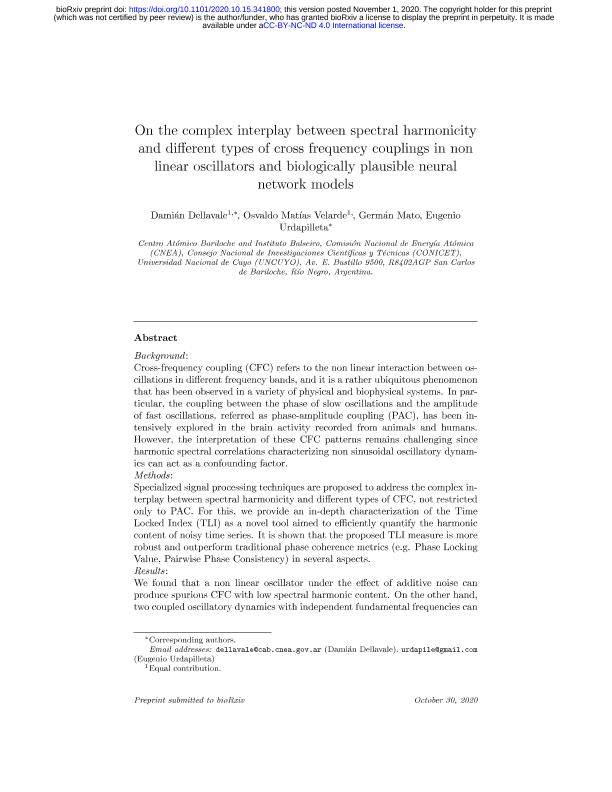Mostrar el registro sencillo del ítem
dc.contributor.author
Dellavale Clara, Hector Damian

dc.contributor.author
Velarde, Osvaldo Matias

dc.contributor.author
Mato, German

dc.contributor.author
Urdapilleta, Eugenio

dc.date.available
2021-02-26T17:21:36Z
dc.date.issued
2020-12
dc.identifier.citation
Dellavale Clara, Hector Damian; Velarde, Osvaldo Matias; Mato, German; Urdapilleta, Eugenio; Complex interplay between spectral harmonicity and different types of cross-frequency couplings in nonlinear oscillators and biologically plausible neural network models; American Physical Society; Physical Review E; 102; 6; 12-2020; 1-77
dc.identifier.issn
2470-0045
dc.identifier.uri
http://hdl.handle.net/11336/126815
dc.description.abstract
Cross-frequency coupling (CFC) refers to the nonlinear interaction between oscillations in different frequency bands, and it is a rather ubiquitous phenomenon that has been observed in a variety of physical and biophysical systems. In particular, the coupling between the phase of slow oscillations and the amplitude of fast oscillations, referred as phase-Amplitude coupling (PAC), has been intensively explored in the brain activity recorded from animals and humans. However, the interpretation of these CFC patterns remains challenging since harmonic spectral correlations characterizing nonsinusoidal oscillatory dynamics can act as a confounding factor. Specialized signal processing techniques are proposed to address the complex interplay between spectral harmonicity and different types of CFC, not restricted only to PAC. For this, we provide an in-depth characterization of the time locked index (TLI) as a tool aimed to efficiently quantify the harmonic content of noisy time series. It is shown that the proposed TLI measure is more robust and outperforms traditional phase coherence metrics (e.g., phase locking value, pairwise phase consistency) in several aspects. We found that a nonlinear oscillator under the effect of additive noise can produce spurious CFC with low spectral harmonic content. On the other hand, two coupled oscillatory dynamics with independent fundamental frequencies can produce true CFC with high spectral harmonic content via a rectification mechanism or other post-interaction nonlinear processing mechanisms. These results reveal a complex interplay between CFC and harmonicity emerging in the dynamics of biologically plausible neural network models and more generic nonlinear and parametric oscillators. We show that, contrary to what is usually assumed in the literature, the high harmonic content observed in nonsinusoidal oscillatory dynamics is neither a sufficient nor necessary condition to interpret the associated CFC patterns as epiphenomenal. There is mounting evidence suggesting that the combination of multimodal recordings, specialized signal processing techniques, and theoretical modeling is becoming a required step to completely understand CFC patterns observed in oscillatory rich dynamics of physical and biophysical systems.
dc.format
application/pdf
dc.language.iso
eng
dc.publisher
American Physical Society
dc.rights
info:eu-repo/semantics/openAccess
dc.rights.uri
https://creativecommons.org/licenses/by-nc-nd/2.5/ar/
dc.subject
cross frequency coupling
dc.subject
coupled oscillators
dc.subject
neuronal networks
dc.subject.classification
Otras Ciencias Físicas

dc.subject.classification
Ciencias Físicas

dc.subject.classification
CIENCIAS NATURALES Y EXACTAS

dc.title
Complex interplay between spectral harmonicity and different types of cross-frequency couplings in nonlinear oscillators and biologically plausible neural network models
dc.type
info:eu-repo/semantics/article
dc.type
info:ar-repo/semantics/artículo
dc.type
info:eu-repo/semantics/publishedVersion
dc.date.updated
2021-02-24T12:02:50Z
dc.identifier.eissn
2470-0053
dc.journal.volume
102
dc.journal.number
6
dc.journal.pagination
1-77
dc.journal.pais
Estados Unidos

dc.description.fil
Fil: Dellavale Clara, Hector Damian. Comisión Nacional de Energía Atómica. Centro Atómico Bariloche; Argentina. Comisión Nacional de Energía Atómica. Gerencia del Área de Energía Nuclear. Instituto Balseiro; Argentina. Consejo Nacional de Investigaciones Científicas y Técnicas. Centro Científico Tecnológico Conicet - Patagonia Norte; Argentina. Universidad Nacional de Cuyo; Argentina
dc.description.fil
Fil: Velarde, Osvaldo Matias. Comisión Nacional de Energía Atómica. Centro Atómico Bariloche; Argentina. Comisión Nacional de Energía Atómica. Gerencia del Área de Energía Nuclear. Instituto Balseiro; Argentina. Consejo Nacional de Investigaciones Científicas y Técnicas. Centro Científico Tecnológico Conicet - Patagonia Norte; Argentina. Universidad Nacional de Cuyo; Argentina
dc.description.fil
Fil: Mato, German. Comisión Nacional de Energía Atómica. Centro Atómico Bariloche; Argentina. Comisión Nacional de Energía Atómica. Gerencia del Área de Energía Nuclear. Instituto Balseiro; Argentina. Consejo Nacional de Investigaciones Científicas y Técnicas. Centro Científico Tecnológico Conicet - Patagonia Norte; Argentina. Universidad Nacional de Cuyo; Argentina
dc.description.fil
Fil: Urdapilleta, Eugenio. Comisión Nacional de Energía Atómica. Centro Atómico Bariloche; Argentina. Comisión Nacional de Energía Atómica. Gerencia del Área de Energía Nuclear. Instituto Balseiro; Argentina. Consejo Nacional de Investigaciones Científicas y Técnicas. Centro Científico Tecnológico Conicet - Patagonia Norte; Argentina. Universidad Nacional de Cuyo; Argentina
dc.journal.title
Physical Review E
dc.relation.alternativeid
info:eu-repo/semantics/altIdentifier/url/https://link.aps.org/doi/10.1103/PhysRevE.102.062401
dc.relation.alternativeid
info:eu-repo/semantics/altIdentifier/doi/http://dx.doi.org/10.1103/PhysRevE.102.062401
Archivos asociados
